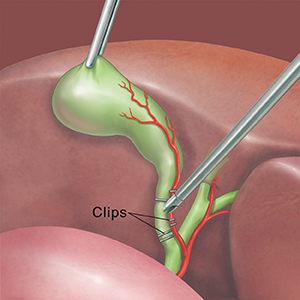Cholecystectomy
Cholecystectomy

Before your surgery
Be prepared:
Tell your provider what medicines you take. Include those bought over the counter. Also include herbs or supplements. Be sure to mention if you take prescription blood thinners. This includes warfarin, clopidogrel, and aspirin.
Have any tests your provider asks for, such as blood tests.
Don’t eat or drink after midnight, the night before your surgery. This includes water, coffee, and mints. However, you may need to take some medicine with sips of water—talk with your healthcare provider.
The day of surgery
When you arrive, you will prepare for surgery:
An IV line will be put into a vein in your arm or hand. This gives you fluids and medicine.
An anesthesiologist will talk with you about anesthesia. This is medicine used to prevent pain. You will receive general anesthesia. This puts you into a state like deep sleep through the procedure.
During surgery
There are 2 methods for removing the gallbladder. Your healthcare provider will choose which method is best for you:
Laparoscopic cholecystectomy. This is most common. During surgery, 2 to 4 small incisions are made. A thin tube with a camera is used. This is called a laparoscope. The scope is put through one of the incisions. It sends images to a video screen. Surgical tools are put through other incisions. The gallbladder is removed using the scope and these tools.
Open cholecystectomy. One larger incision is made. The surgeon sees and works through this incision. Open surgery is most often used when scarring or other factors make it a better choice for you.
In some cases, safety requires a change from laparoscopic to open surgery during the procedure.
After surgery
You will be sent to a room to wake up from the anesthesia. You will likely go home the same day. In some cases, an overnight stay is needed. If you had open cholecystectomy, you may need to stay in the hospital for a few days. When you are released to go home, have a family member or friend ready to drive you.
Risks and possible complications of gallbladder surgery
All surgeries have risks. The risks of gallbladder surgery include:
Bleeding
Infection
Injury to the common bile duct or nearby organs
Blood clots in the legs
Bile leaks
Hernia at incision site
Pnemonia
Updated:
March 21, 2017
Reviewed By:
Fraser, Marianne, MSN, RN,Lehrer, Jenifer, MD